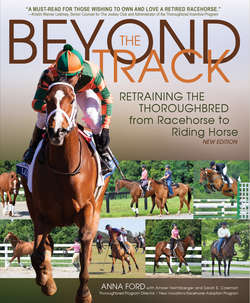Читать книгу Beyond the Track - Anna Morgan Ford - Страница 21
На сайте Литреса книга снята с продажи.
Race Day
ОглавлениеHorses may race as often as once a week, once a month, or several times a year. How often the horse races is determined by his owner and trainer, who also decide the type and length of races, and whether he will run on dirt or turf.
A Racehorse’s Typical Schedule*
4:30–5:00 A.M. Feeding and mucking out
6:00–11:00 A.M. Walking or exercising on the track, followed by bathing, hand-walking until cool, and grooming
12:00 P.M. Midday feed
2:00–3:00 P.M. Hand-walking
5:00–6:00 P.M. Evening feed
*Every detail concerning each horse is monitored and changes to his schedule are made as necessary.
Horses not permanently stabled at the track are usually shipped in on race day. During a race, the stable area is a high-security area—only those directly involved with the horses, or those with special permission, are allowed to be there. This prevents random onlookers from getting in the way of preparation and is also a safety measure against foul play—a worry wherever betting is involved.
RACE DAY
1.8 A–E Thoroughbreds are paraded and saddled in the paddock on race day. There it is a hubbub of activity as grooms, jockeys, owners, and trainers make last minute preparations—all within reach of the spectators (A–C). Once the jockeys are up, the field walks by the grandstand on the way to the starting gate (D). The most intense and congested moment of the race is when the bell sounds and the horses take off (E).
If you have ever seen a race in person, or even on television, you have witnessed the incredible amount of activity a Thoroughbred is exposed to before, during, and after a race. About 30 minutes before a race, handlers, followed by the grooms and owners, lead the horses to the paddock. The paddock tends to be a grassy space with a circular path around the perimeter, usually enclosed by a short fence or hedge. Here the horses are saddled, walked, and mounted by their jockey. Although only trainers, owners, and those with special permission are allowed in the paddock prior to a race, it is typically crowded with people and often chaotic. Large numbers of spectators surround the area, and people hang over the fence trying to get a look at the horses before they place their bets.
Most paddocks have open-faced “saddling stalls” where the horses are tacked-up after they are paraded around the perimeter and the trainer gives the go-ahead. It is common to see horses appear anxious and buck or dance around as their girths are tightened. The trainers then do a last-minute check of the horse’s condition and equipment themselves.
Once saddled, the horses are again paraded around the paddock in their race order until they meet up with their jockey, who is helped to mount. The field is then escorted to the track by a “lead horse.” When they reach the track, the ground handlers release their charges to handlers on horseback—and then follows the familiar scene of the field parading in front of the grandstand.
Some horses jog toward the starting area, while others do a slow gallop and then a quick warm-up. As post time—when all race entries are due at the starting post—draws near, all the horses are called to their gate, where ground handlers are on hand to assist the jockeys. As soon as the last horse is securely loaded, the bell rings, and they’re off!
Right out of the gate there is a lot of action and commotion as jockeys fight for a good position closest to the rail. Most of the horses will be part of a tight pack, with all but those in front getting dirt or mud thrown in their faces. Through it all, jockeys are talking or yelling, whips are swinging, and the crowd is screaming at the finish line.
Depending on the length of the race, most will be over in about two minutes (one of the amazing aspects of the sport is how much time and training goes into preparing for such a brief exercise in power). While the first horse over the finish line (barring disqualification or a challenge) is ridden directly to the Winner’s Circle, the rest of the field heads to an exit gate where their grooms and trainers meet them. There, the jockeys hop off and the horses are quickly stripped of their saddles, and then sponged or hosed down before they are walked back to the barn. At the barn they are fully untacked and thoroughly bathed, then walked until cool.
Once the final order of the field is declared official, the first- and second-place horses have their blood and urine tested for illegal drugs, and random horses are also tested.
Before being fed and put away for the night, horses that raced are examined and their legs are wrapped to keep any inflammation at bay. With a thick layer of bedding and plenty of hay, they are then left alone to recover.
